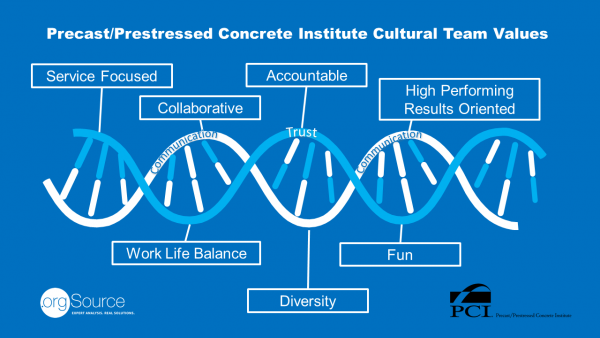Good Culture Makes Good Sense

Smiley or sad—which describes your culture? Some people work on a dream team. Others are ready to be a statistic in the Great Resignation. What makes the difference? If your answer was people, go to the head of the class.
When I want to explore interpersonal dynamics in the workplace, I look to .orgSource consultant Kevin Martlage. In addition to years of corporate and association team-building experience, Kevin is a certified Myers-Briggs practitioner. He is eminently qualified to get groups on track to their happy place, that spot where they communicate smoothly enough to achieve big goals.
We recently had a conversation about the importance of culture and its impact on organizational success. I’m excited to share Kevin’s ideas with you.
We’ve all experienced how easily disruption can fracture teams. Shared values are the glue that keeps people pulling together through turbulence and change. Remote work quickly revealed the groups whose vision for success wasn’t strong enough to sustain positive collaboration.
“Culture is the X factor,” Kevin observes. “You may support a robust profession with members who are eager for new products and services. But it’s not enough. Culture is the foundation that allows you to be sustainable. When Associations understand that powerful idea, they can weather the storms and grow.”
If only you could snap your fingers and make everyone play nicely together. Unfortunately, like life, work is also messy. Culture is a garden that requires constant attention to prevent weeds from encroaching on your careful design. But there are strategies that can help, and professionals like Kevin to show you how to use them.
Understand Yourself and Your Team
If you are the leader, creating the result you want begins with you. Your example is the most powerful form of persuasion. The Myers-Briggs Type Indicator is a tool to help people develop self-awareness and insight into their personalities and how they prefer to interact in the world and with others.
The instrument was developed by Isabel Briggs Myers and her mother Katharine Cook Briggs in 1940. They were students of Carl Jung’s theory of psychological types. The pair felt that his ideas could have significant practical applications for people and groups. Isabel Briggs Myers explained the impact of their work like this.
“The understanding of type can make your perceptions clearer, your judgments sounder, and your life closer to your heart’s desire. . . When people differ, a knowledge of type lessens friction and eases strain. In addition, it reveals the value of differences. No one has to be good at everything.”

You may have heard people use acronyms like INFJ or ENTP when talking about the Myers-Briggs. Those letters represent the scales of individual preferences listed below. These attitudes are used to define the MBTI personality type.
- Introversion-Extraversion
- Sensing-Intuition
- Thinking-Feeling
- Judging-Perceiving
The system allows for 16 possible combinations.
Taking the inventory is a fun and effective way to ease into conversations about communication, behavior, trust, and other interpersonal issues that are important to keeping culture on track.
“Myers-Briggs can transform teams,” Kevin advises. “As groups begin to understand how their colleagues assimilate information and make decisions, they gain confidence and trust in each other.”
In addition to being a vehicle for discovery, the inventory can also serve as a problem-solving tool.
“Sometimes we arrive at the root cause of a challenge by looking inward,” Kevin observes. “Your results can shine a flashlight into areas you may not have considered and be a mirror that reflects how your behavior impacts others.
“My father, who is a Myers-Briggs Master Practitioner, urged me to get certified,” Kevin explains. “I’ve found this knowledge to be incredibly valuable in my work with organizations and for myself. I learned things about my personality that would have been beneficial to understand early in my career.”
Find Your Group DNA
Assessing individual styles and preferences is a prelude to developing the shared values that I mentioned earlier. That is the real work of building a positive culture. Kevin related how one of his .orgSource clients, the Precast, Prestressed Concrete Institute, created the model that represents their group’s cultural identity and the guiding principles for their initiatives and interactions.
Founded in 1954, the Precast, Prestressed Concrete Institute is the technical institute and trade association for the precast, prestressed concrete structures industry. As a technical institute, PCI develops, maintains, and disseminates the Body of Knowledge for the design, fabrication, and erection of precast concrete structures and systems.
“PCI’s President and CEO, Bob Risser, PE, wanted to make his organization an exceptional place to work. He thought helping his team to identify a common purpose and goals, or their unique DNA, would be a good start,” Kevin recalls.

“We set out to discover the touchstones for the team’s interactions and activities. Through ideation and strategy, we arrived at seven qualities that characterize their business culture. Then we went on to describe the behaviors that each criterion represents for the group. For example, collaboration was of high importance, and someone who demonstrates that trait would—”
- Encourage collaboration
- Ask for help
- Establish team member roles
- Establish the team and lead
- Give constructive feedback
- Welcome and act upon feedback
This level of specificity provides a common language for the group to describe the professional environment they are seeking to achieve. It also helps to put conversations about attitude and behavior in an objective framework. “Now when people ask what it’s like to work at PCI,” Kevin notes, “we can point to these specific values that drive the culture.
“The next step in the process is to determine where the staff sees the group in relation to their benchmarks. We distributed a survey that’s designed to evaluate how the PCI is meeting the staff’s expectations in each of the priority areas.
“Bob, along with the leadership team, opened the hood on the organization. They did the hard work to discover how they define excellence as a group and how they intend to get there. I’m excited to see where they will go from here.”
Stay Ahead of Challenges
Because culture is intangible, it sometimes gets lower billing than more visible priorities. I asked Kevin what leaders who want to stay ahead of problems can do.
“Intentionality and a servant mindset are important,” Kevin noted. “You need to put the team ahead of yourself and let them know that you are invested in helping them meet their goals. Taking a page from PCI and understanding your values, then hiring people who fit that cultural model and will help support it is also critical.”
We all want to work on a dream team. Having the courage to shine a light on yourself and take a hard look in the mirror, is the first step to getting there.

